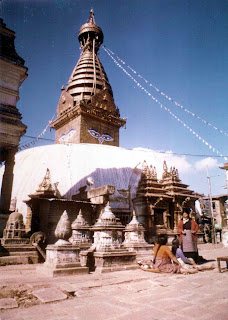Swayambhunath Temple

- Swayambhunath Temple is an ancient religious area on the top of a hill in the Kathmandu valley, located west of Kathmandu city. It is also known as Monkey temple as there are holy monkeys living in parts of the temple in the North West place. It is the most ancient and enigmatic of all the holy shrines in Kathmandu valley. Its lofty white dome and glittering golden spire are visible for many miles from all sides of valley. According to historical records founds on stone inscription give evidence that the temple was already important Buddhist pilgrimage destination by the fifth century AD. The Tibetan name for the site means “ Sublime Trees “ for the many trees found on the hill .However Shing Kun may be a corruption of local Newari name this complex as Singgu is known as “ Self Sprung “ Swayambhunath occupies a central position and most probably the sacred among Buddhist pilgrimage sites. A collection of legends about the sites, the fifteen century Swayambhu purana, tells of a miraculous lotus, planted by a past Budha,which blossomed from the lake that once covered Kathmandu valley .The lotus mysteriously radiated a brilliant light and the name of the place come to be Swayambhu, known as “ Self Created “ as “ Self Existent “.Saint sages and divinities traveled to the lake to venerated this miraculous light for its power in granting enlightenment. During this time, the Bodhisattva Manjushree was meditating at the sacred mountain of Wu Tai Shan and had a vision of the dazing Swayambhu light.Manjushree flew across the mountain of china and Tibet upon his blue lion to worship the lotus.Seeply impressed by the power of the radiant light, Manjushree felt that if the water is drained out of the lake Swyambhu would became more easily accessible to human pilgrim. With a great sword Manjushree cut a gorge in the mountain surrounding the lake. The water. draining away, left the valley of present day of Kathmandu.The otus was then transformed into a hill and light became the Swayambhunath’s worshipper include Hindus,Vajrayana Buddhist of north of Nepal and Tibet and Newari Buddhist of central and south of Nepal. Each morning before dawn, hundred of pilgrims will ascend the three hundred sixty five steps that lead up the hill, file past the gilded Vajra known as Tibetan Darje.The area surrounding is filled with chaityas,other temples, painted image of deities and numerous other objects. There are many other small shrines with statues of Tantric and shamanistic deities, prayers wheel for the Tibetan Buddhist, Shiva lingam and popular Hindus temples dedicated to Harati Mata Devi the Goddess of small pox and other prevalent among community at special time. The presence of the Harati Devi symbolizes the intermingling of the pantheons of Hinduism and Buddhism in the development of the religious trends of Nepal. As Buddhist had no deity in their own pantheon to protect against the dreaded smallpox, the adopted the Hindu deity for assistance.

Swayambhunath Temple is a sacred place for the Buddhist pilgrimage and engage a central point for the Buddhist Newars whose origin is from the myths and continues their religious practices. The stupa is actually comprised of a dome down the bottom and this dome symbolizes the complete world. If you want to experience this ancient temple then try to climb the stairway where at the entrance you will find two lions are guarding there.
ReplyDelete